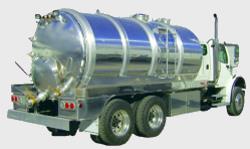
The vacuum pump is powered by either the truck engine or a dedicated diesel or gasoline motor. Most industrial vacuum truck are purpose built on a heavy duty chassis, though sliding units are available that can be installed in a truck bed or on a trailer.
Material Transported
Industrial vacuum trucks are equipped to service the remediation, transportation, and industrial services sectors. They are capable of removing and hauling both hazardous and non-hazardous liquids and semi-solids, from heavy sludge to fly ash. If any substance is loose enough to be pumped and removed, vacuum truck can do it.
The material can vary:
• Sewage from a septic tank or sewer.
• Contaminated soil pollution.
• Brine water from oil well drilling sites.
Liquids ideally require different industrial vacuum pump trucks than solids. The vacuum tubes are between 1 to 4 inches in diameter depending on the requirements of the job.
Boom reach
To gain access to hard to reach areas, an industrial vacuum truck may be equipped with a boom. The water suction hose is attached to the boom arm, facilitating the positioning and control of the tube over the desired work area. It is also helpful when servicing a residential septic tank or a remote oil drill site or when obstacles prevent the truck from reaching the site.
Hose
The diameter of the vacuum hose has an important impact when selecting and fitting them to the truck. Hose diameter impacts the operator’s productivity; therefore changing hose diameters in the middle of the job is not only inefficient; it can be dangerous.
Safety
Given the type of materials and the worksite conditions and the nature of vacuum truck workers need proper training to cover the hazards they are exposed to. Workers must use personal protective equipment such as a H2S personal alarms and air supplied respirators. They need training in the hazards of toxic gas exposure and what to do in case they come in contact.
H2S (Hydrogen Sulfide)
During the industrial vacuum truck operation, workers need to be aware of the hazards of exposure to toxic gases. Toxic gases are released whenever vacuum truck suck up liquid waste to be transported to waste disposal companies. For example, waste water from oil and gas wells may contain toxic gases such as hydrogen sulfide (H2S).
Low levels of exposure to H2S may result in symptoms such as eye irritation, sore throat, nausea, and vomiting. At high levels of exposure, workers not wearing protective gear will pass out. At higher levels of exposure, the gas can be fatal within seconds. H2S is one of many toxic gases that exist around vacuum truck operations.
The mixing of liquid waste with other waste materials may result in unknown chemical reactions producing gases as dangerous as H2S. For example, hydrochloric acid used in the oil and gas industry may react with waste materials already in a vacuum tank truck that then releases hydrochloric acid fumes. These fumes are potentially lethal if workers are not wearing protective equipment.
Vacuum truck operators should always put safety first keep in mind several things when operating a vacuum truck.
 RSS Feed
RSS Feed